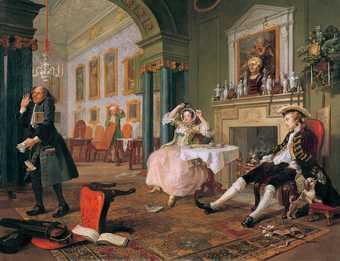
William Hogarth, Marriage A-la-Mode: 2, The Tête à Tête, c 1743. The National Gallery, London
3 November 2021 – 20 March 2022
Open daily 10.00 – 18.00
For public information call +44(0)20 7887 8888, visit tate.org.uk or follow @Tate #HogarthandEurope
Supported by Mala Gaonkar, with additional support from the Hogarth & Europe exhibitions circle, Tate Americas Foundation, Tate International Council and Tate Patrons
Few artists have defined an era as much as William Hogarth (1697-1764), whose vivid, satirical depictions of 18th century England continue to capture the imagination today. Tate Britain’s major exhibition Hogarth and Europe will present his work in a fresh light, seen for the first time alongside works by his continental contemporaries. It will explore the parallels and exchanges that crossed borders and the cosmopolitan character of Hogarth’s art. Hogarth’s best-known paintings and prints, such as Marriage A-la-Mode 1743, The Gate of Calais 1748 and Gin Lane 1751, will be shown alongside works by famed European artists, including Jean-Siméon Chardin in Paris, Pietro Longhi in Venice, and Cornelis Troost in Amsterdam. Together they will reveal how changes in society took art in new directions, both in Britain and abroad.
Featuring over 60 of Hogarth’s works, brought together from private and public collections around Europe and North America, the exhibition will draw on decades of research to show Hogarth in all his complexity – whether as staunch patriot or sharp critic, bawdy satirist or canny businessman. It will also examine the shifting status of artists in the 18th century, from workshop artisans and court painters to independent freelancers enjoying prominence alongside actors, musicians and writers. The rapid expansion of urban centres like London, Paris, Amsterdam and Venice also saw the city itself become a major subject in art for the first time. Tate Britain will juxtapose these metropolitan scenes from across Europe, showing the bustling London streets of Hogarth’s Southwark Fair 1733 and The March of the Guards to Finchley 1749-50 together with vibrant depictions of Étienne Jeaurat’s Paris and Longhi’s Venice.
This was an age of opportunity and innovation, but also materialism, self-delusion, exploitation and injustice. In Europe, new heights of luxury emerged with extreme poverty, while growing cities saw overcrowding and disease. The rising demand for consumer goods at home came at the expense of the labour and lives of enslaved and colonised people overseas. Against the backdrop of this changing world, artists like Hogarth pioneered a new painting of modern life, revealing its pleasures and dynamism but also its dangers and stark inequalities. In the 1730s he began his ‘modern moral series’: frank and engaging narratives charting the rise and fall of everyday characters corrupted by immorality and vice. Hogarth and Europe will showcase these celebrated series, including A Rake’s Progress 1734, which were immediately popular and widely circulated through print. At Tate Britain they will be seen alongside paintings by the Italian Giuseppe Crespi, including The Flea 1707-09, and the Parisian Nicolas Lancret, to show how this new artistic genre of urban storytelling developed across Europe.
The 18th century also saw greater informality and ease in portraiture, expressing the new ideas emerging around individuality and personal freedom that remain familiar today. The exhibition will culminate in a room focussing on such pictures, including Miss Mary Edwards 1742 – a painting not seen in the UK for over a century – depicting the eccentric, wealthy patron who commissioned many of Hogarth’s best-known works. Additional highlights will include paintings of his sisters Mary and Anne Hogarth, as well as Heads of Six of Hogarth's Servants c.1750-55. Through juxtapositions with European artworks, the exhibition will look afresh at these and many other works by one of Britain’s most important artists, giving visitors a chance to see Hogarth’s position on the international stage in a new light.
Hogarth and Europe is curated by Alice Insley, Curator, British Art c 1730 - 1850 and Martin Myrone, former Senior Curator, pre-1800 British Art, Tate Britain. It will be accompanied by a fully illustrated catalogue featuring new essays by eminent scholars and artists including Lubaina Himid and Sonia E Barrett.
